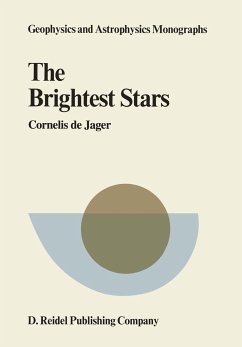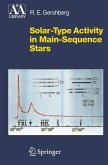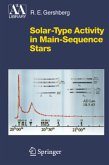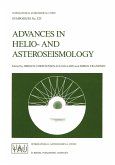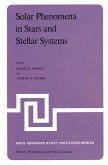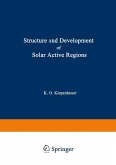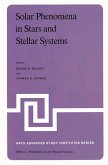C. de Jager
The Brightest Stars
C. de Jager
The Brightest Stars
- Gebundenes Buch
- Merkliste
- Auf die Merkliste
- Bewerten Bewerten
- Teilen
- Produkt teilen
- Produkterinnerung
- Produkterinnerung
No part of the Hertzsprung-Russell diagram shows a more pronounced diversity of stellar types than the upper part, which contains the most luminous stars. Can one visualize a larger difference than between a luminous, young and extremely hot Of star, and a cool, evolved pulsating giant of the Mira type, or an S-type supergiant, or - again at the other side of the diagram - the compact nucleus of a planetary nebula? But there is order and unity in this apparent disorder! Virtually all types of bright stars are evolutionally related, in one way or the other. Evolution links bright stars. In many…mehr
Andere Kunden interessierten sich auch für
![The Brightest Stars The Brightest Stars]() C. de JagerThe Brightest Stars39,99 €
C. de JagerThe Brightest Stars39,99 €![Solar-Type Activity in Main-Sequence Stars Solar-Type Activity in Main-Sequence Stars]() Roald E. GershbergSolar-Type Activity in Main-Sequence Stars77,99 €
Roald E. GershbergSolar-Type Activity in Main-Sequence Stars77,99 €![Solar-Type Activity in Main-Sequence Stars Solar-Type Activity in Main-Sequence Stars]() Roald E. GershbergSolar-Type Activity in Main-Sequence Stars75,99 €
Roald E. GershbergSolar-Type Activity in Main-Sequence Stars75,99 €![Advances in Helio- And Asteroseismology Advances in Helio- And Asteroseismology]() Jrgen Christensen-Dalsgaard / Sren Frandsen (eds.)Advances in Helio- And Asteroseismology103,99 €
Jrgen Christensen-Dalsgaard / Sren Frandsen (eds.)Advances in Helio- And Asteroseismology103,99 €![Solar Phenomena in Stars and Stellar Systems Solar Phenomena in Stars and Stellar Systems]() R.M. Bonnet (ed.) / A.K. DupreeSolar Phenomena in Stars and Stellar Systems103,99 €
R.M. Bonnet (ed.) / A.K. DupreeSolar Phenomena in Stars and Stellar Systems103,99 €![Structure and Development of Solar Active Regions Structure and Development of Solar Active Regions]() K.O. Kiepenheuer (ed.)Structure and Development of Solar Active Regions103,99 €
K.O. Kiepenheuer (ed.)Structure and Development of Solar Active Regions103,99 €![Solar Phenomena in Stars and Stellar Systems Solar Phenomena in Stars and Stellar Systems]() Solar Phenomena in Stars and Stellar Systems39,99 €
Solar Phenomena in Stars and Stellar Systems39,99 €
No part of the Hertzsprung-Russell diagram shows a more pronounced diversity of stellar types than the upper part, which contains the most luminous stars. Can one visualize a larger difference than between a luminous, young and extremely hot Of star, and a cool, evolved pulsating giant of the Mira type, or an S-type supergiant, or - again at the other side of the diagram - the compact nucleus of a planetary nebula? But there is order and unity in this apparent disorder! Virtually all types of bright stars are evolutionally related, in one way or the other. Evolution links bright stars. In many cases the evolution is speeded up by, or at least intimately related to various signs of stellar instability. Bright stars lose mass, either continuously or in dramatic sudden events, they vibrate or pulsate - and with these tenuous, gigantic objects this often happens in a most bizarre fashion. Sometimes the evolution goes so fast that fundamental changes are observable in the time span of a human's life - several of such cases have now been identified.
Produktdetails
- Produktdetails
- Geophysics and Astrophysics Monographs .19
- Verlag: Springer Netherlands / Springer, Berlin
- 1980.
- Seitenzahl: 470
- Erscheinungstermin: 30. November 1980
- Englisch
- Gewicht: 1040g
- ISBN-13: 9789027711090
- ISBN-10: 9027711097
- Artikelnr.: 24462791
- Herstellerkennzeichnung
- Libri GmbH
- Europaallee 1
- 36244 Bad Hersfeld
- gpsr@libri.de
- Geophysics and Astrophysics Monographs .19
- Verlag: Springer Netherlands / Springer, Berlin
- 1980.
- Seitenzahl: 470
- Erscheinungstermin: 30. November 1980
- Englisch
- Gewicht: 1040g
- ISBN-13: 9789027711090
- ISBN-10: 9027711097
- Artikelnr.: 24462791
- Herstellerkennzeichnung
- Libri GmbH
- Europaallee 1
- 36244 Bad Hersfeld
- gpsr@libri.de
1: The Upper Boundaries of the Hertzsprung-Russell Diagram.- 1.1. Preamble.- 1.2. The Most Luminous Stars.- 1.3. Gravitational Acceleration Versus Radiation Forces.- 1.4. Inclusion of the Mass-Luminosity Relation.- 1.5. The Effective Value of the Acceleration of Gravity; Influence of Radiation Pressure.- 1.6. Influence of Rotation and of Turbulent Motions.- 1.7. Boundaries to the Hertzsprung Russell Diagram.- 1.8. Terminology Related to Extended Atmospheres.- 2: The Main Observational Characteristics of the Most Luminous Stars.- 2.1. Spectral and Luminosity Classification.- 2.2. Absolute Magnitude and Luminosity Criteria.- 2.3. The Effective Temperature Scale and the Bolometric Correction.- 2.4. Masses of Massive Stars.- 2.5. Radii of Luminous Stars.- 2.6. geff-Values in Extreme Objects.- 2.7. The Distribution of Light over the Surface of Supergiants.- 2.8. Magnetic Fields of Luminous Stars.- 2.9. Turbulent Velocities.- 2.10. Rotational Velocities in Atmospheres of Bright Stars.- 2.11. Polarization of Light of Stars with Extended Atmospheres.- 3: Spectral Characteristics and Stellar Parameters for the Main Groups of Luminous Stars; Some Prototypes.- 3.1. O- and Bright B-Stars.- 3.2. The Of and Oef Stars.- 3.3. The Most Luminous Galactic Star.- 3.4. The Wolf-Rayet Stars.- 3.5. The P Cygni Stars, and P Cygni Profiles.- 3.6. The Oe, Be-, and Shell-Type Stars.- 3.7. The CNO-Stars (or: OBCN Stars).- 3.8. The Super-Supergiants (Hypergiants).- 3.9. The Most Luminous Extragalactic Star..- 3.10. G- and K-Type Supergiants; Zeta Aurigae Stars.- 3.11. The Coolest of the Bright Stars.- 3.12. The Central Stars of Planetary Nebulae.- 4: The Evolution of Massive Stars.- 4.1. The First Phases of the Evolution of Massive Stars.- 4.2. The Main Sequence; Life Times, Stability.- 4.3. Post-Main-Sequence Evolution of Massive Stars.- 4.4. Convection and Semi-Convection.- 4.5. The Influence of Mass-Loss on the Evolution of Massive Stars.- 4.6. Stellar Abundances and Nuclear Reactions; the Influence of Thermal Pulses.- 4.7. The Mira Stars.- 4.8. The Carbon Burning and Later Phases.- 4.9. Supernovae.- 4.10. Evolution of Close Massive Binaries.- 4.10.1. The Roche Surface.- 4.10.2. Evolution of Close Binary Stars; the Conservative Case.- 4.10.3. Evolution of Close Binaries in the Non-Conservative Case.- 4.10.4. The Last Phases of Binary Star Evolution.- 4.11. The Origin of Wolf Rayet Stars.- 4.12. The Origin of X-Ray Binaries; Mass Transfer onto a Compact Companion.- 4.13. Stellar Rotation and Evolution.- 5: The Structure of Very Tenuous Stellar Atmospheres.- 5.1. Atmospheric Models; Radiative or Convective Equilibrium.- 5.2. The Assumption of Plane-Parallel Atmospheric Layers.- 5.3. Models of Very Tenuous Atmospheres; the Plane-Parallel Case.- 5.4. Models of Extended and Spherical Stellar Atmospheres; the Static Case.- 5.5. Expanding Spherical Stellar Atmospheres; Introduction.- 5.6. The Radiation Force on Outer Stellar Layers.- 5.7. Radiation-Driven Expanding Atmospheres; the Subsonic Region.- 5.8. Line-Driven Stellar Winds.- 5.9. Model Envelopes of Early-Type Stars with Line-Driven Stellar Winds.- 5.10. Convection in Supergiant Atmospheres.- 6: Chromospheres, Coronae, Gas and Dust Around Luminous Stars.- 6.0. Generalities.- 6.1. What is a Stellar Chromosphere ?.- 6.2. Conditions for the Occurrence of Emission Lines; Chromospheric Indicators.- 6.3. Observations in Some Chromospheric Indicators.- 6.4. Properties of Chromospheres and Warm Envelopes in Various Types of Stars as Derived from Spectral Investigations.- 6.5. Outward Increase of the Source Function or the Temperature in Near-Photospheric Layers.- 6.6. Chromospheric and Coronal Heating the Solar Case.- 6.7. Wave Modes in a Stellar Photosphere.- 6.8. The Generation of Mechanical Fluxes in Stellar Photospheres.- 6.9. Comparison of Predicted and Observed Stellar Mechanical Fluxes.- 6.10. The Computation of Stellar Coronal Parameters.- 6.10.1. Historical and General Remarks.- 6.10.2. The Non-Magnet
1: The Upper Boundaries of the Hertzsprung-Russell Diagram.- 1.1. Preamble.- 1.2. The Most Luminous Stars.- 1.3. Gravitational Acceleration Versus Radiation Forces.- 1.4. Inclusion of the Mass-Luminosity Relation.- 1.5. The Effective Value of the Acceleration of Gravity; Influence of Radiation Pressure.- 1.6. Influence of Rotation and of Turbulent Motions.- 1.7. Boundaries to the Hertzsprung Russell Diagram.- 1.8. Terminology Related to Extended Atmospheres.- 2: The Main Observational Characteristics of the Most Luminous Stars.- 2.1. Spectral and Luminosity Classification.- 2.2. Absolute Magnitude and Luminosity Criteria.- 2.3. The Effective Temperature Scale and the Bolometric Correction.- 2.4. Masses of Massive Stars.- 2.5. Radii of Luminous Stars.- 2.6. geff-Values in Extreme Objects.- 2.7. The Distribution of Light over the Surface of Supergiants.- 2.8. Magnetic Fields of Luminous Stars.- 2.9. Turbulent Velocities.- 2.10. Rotational Velocities in Atmospheres of Bright Stars.- 2.11. Polarization of Light of Stars with Extended Atmospheres.- 3: Spectral Characteristics and Stellar Parameters for the Main Groups of Luminous Stars; Some Prototypes.- 3.1. O- and Bright B-Stars.- 3.2. The Of and Oef Stars.- 3.3. The Most Luminous Galactic Star.- 3.4. The Wolf-Rayet Stars.- 3.5. The P Cygni Stars, and P Cygni Profiles.- 3.6. The Oe, Be-, and Shell-Type Stars.- 3.7. The CNO-Stars (or: OBCN Stars).- 3.8. The Super-Supergiants (Hypergiants).- 3.9. The Most Luminous Extragalactic Star..- 3.10. G- and K-Type Supergiants; Zeta Aurigae Stars.- 3.11. The Coolest of the Bright Stars.- 3.12. The Central Stars of Planetary Nebulae.- 4: The Evolution of Massive Stars.- 4.1. The First Phases of the Evolution of Massive Stars.- 4.2. The Main Sequence; Life Times, Stability.- 4.3. Post-Main-Sequence Evolution of Massive Stars.- 4.4. Convection and Semi-Convection.- 4.5. The Influence of Mass-Loss on the Evolution of Massive Stars.- 4.6. Stellar Abundances and Nuclear Reactions; the Influence of Thermal Pulses.- 4.7. The Mira Stars.- 4.8. The Carbon Burning and Later Phases.- 4.9. Supernovae.- 4.10. Evolution of Close Massive Binaries.- 4.10.1. The Roche Surface.- 4.10.2. Evolution of Close Binary Stars; the Conservative Case.- 4.10.3. Evolution of Close Binaries in the Non-Conservative Case.- 4.10.4. The Last Phases of Binary Star Evolution.- 4.11. The Origin of Wolf Rayet Stars.- 4.12. The Origin of X-Ray Binaries; Mass Transfer onto a Compact Companion.- 4.13. Stellar Rotation and Evolution.- 5: The Structure of Very Tenuous Stellar Atmospheres.- 5.1. Atmospheric Models; Radiative or Convective Equilibrium.- 5.2. The Assumption of Plane-Parallel Atmospheric Layers.- 5.3. Models of Very Tenuous Atmospheres; the Plane-Parallel Case.- 5.4. Models of Extended and Spherical Stellar Atmospheres; the Static Case.- 5.5. Expanding Spherical Stellar Atmospheres; Introduction.- 5.6. The Radiation Force on Outer Stellar Layers.- 5.7. Radiation-Driven Expanding Atmospheres; the Subsonic Region.- 5.8. Line-Driven Stellar Winds.- 5.9. Model Envelopes of Early-Type Stars with Line-Driven Stellar Winds.- 5.10. Convection in Supergiant Atmospheres.- 6: Chromospheres, Coronae, Gas and Dust Around Luminous Stars.- 6.0. Generalities.- 6.1. What is a Stellar Chromosphere ?.- 6.2. Conditions for the Occurrence of Emission Lines; Chromospheric Indicators.- 6.3. Observations in Some Chromospheric Indicators.- 6.4. Properties of Chromospheres and Warm Envelopes in Various Types of Stars as Derived from Spectral Investigations.- 6.5. Outward Increase of the Source Function or the Temperature in Near-Photospheric Layers.- 6.6. Chromospheric and Coronal Heating the Solar Case.- 6.7. Wave Modes in a Stellar Photosphere.- 6.8. The Generation of Mechanical Fluxes in Stellar Photospheres.- 6.9. Comparison of Predicted and Observed Stellar Mechanical Fluxes.- 6.10. The Computation of Stellar Coronal Parameters.- 6.10.1. Historical and General Remarks.- 6.10.2. The Non-Magnet

